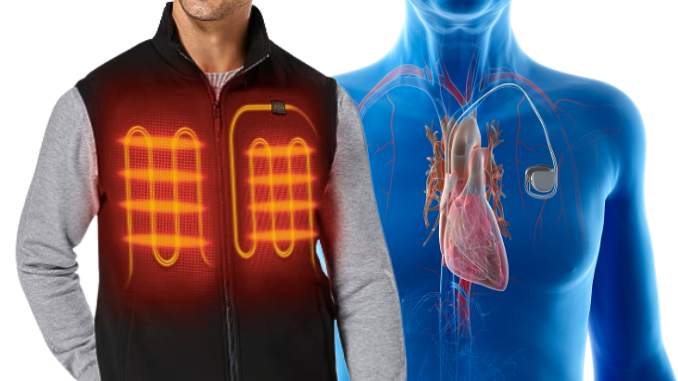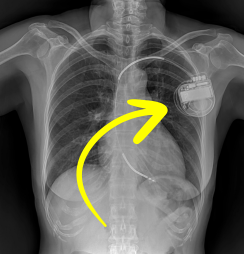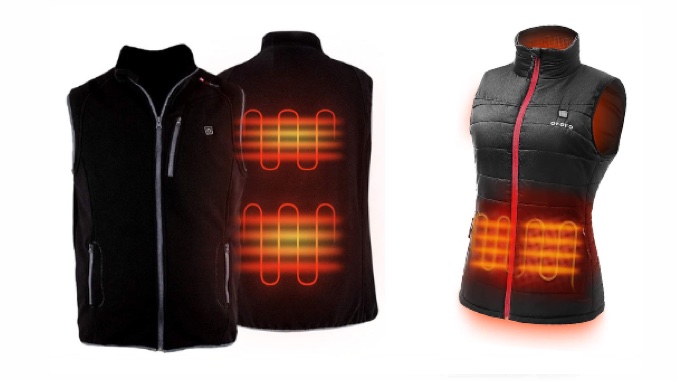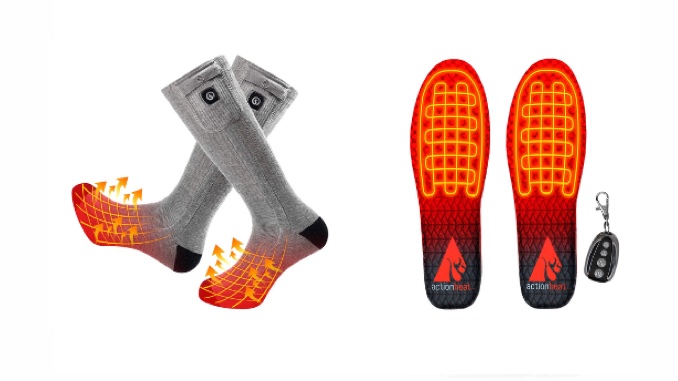
Please note: As an Amazon Associate we earn from qualifying purchases. Details here.
Can someone with a pacemaker wear a heated vest?
Yes, you can wear a heated vest if you have a pacemaker, but do take some precautions. Heated vests give off small electromagnetic fields (EMF), which could mess with how your pacemaker works if the vest’s heating elements or battery are too close to your chest.
To stay safe, check with your doctor first, pick a low-EMF vest, and keep an eye out for any unusual symptoms while wearing it. That way, you can stay warm without worrying about your pacemaker or compromising your heart health.
Look…
Winter is here, and staying warm is a top priority for many.
Heated clothing can make braving the cold much more comfortable. But if you have a cardiac implant, you’re probably wondering:
- Are heated vests safe for pacemakers?
- Do heated vests interfere with pacemakers?
- Or is this sleeveless garment a health hazard?
It’s not just about comfort; it’s about protecting your heart.
Without further ado, let’s cover everything you need to know to stay both safe and warm this winter.
What Does a Pacemaker Do?

Alright.
As someone who wears a pacemaker, you sure do know what it does, but I’ll still mention it.
Pacemaker is a small, battery-operated device implanted in your chest to help regulate your heartbeat.
(A lifesaver for people with heart conditions like arrhythmias.)
It monitors your heart’s electrical activity and sends tiny electrical pulses to keep your heart beating steadily.
However, these devices are sensitive to electromagnetic interference (EMI).
And because EMI from external electronic devices can disrupt the pacemaker’s ability to function properly, it’s natural to wonder: “are heated vests safe for pacemakers?”.
And this is where you need to understand how electric powered pieces of clothing work too, and whether they can affect your heart health.
How Heated Vests Work
Heated vests are powered by rechargeable batteries.
Good heated companies use batteries that are safety-certified, so not only do they keep you warm, but they’re also designed to be safe to use.
They also use built-in heating elements, often made from materials like carbon fiber or graphene, to generate warmth.
Most vests allow users to control the temperature via buttons on the vest or through a smartphone app. That’s why they’re a popular choice for activities in the cold, offering adjustable warmth at the touch of a button.
And yes, there’s a catch:
They generate low levels of electromagnetic fields (EMF).
Normally, the modern heated vests use low-voltage lithium batteries, like 5V, 7.4V, or 12V, which means the electrical current and electromagnetic fields they give off are super low and not really something to worry about.

And while these fields are safe for most people, they can be problematic for folks with pacemakers due to the proximity of the heating elements to the chest area.
What Is the Impact of EMI on Pacemakers?
As we’ve already established, electromagnetic interference occurs when an external electric or magnetic field disrupts the normal operation of a device.
For pacemakers, EMI can:
- Interrupt Signals: The pacemaker might misread the body’s natural electrical signals, leading to irregular heartbeats.
- Cause Malfunctions: Prolonged or strong EMI exposure might cause the pacemaker to stop or misfire temporarily.
The level of interference depends on factors like the strength of the EMF, the duration of exposure, and the distance between the pacemaker and the source of the interference.
Now…
Heated vests, with their heating elements located near the chest, may pose a unique challenge.
But there’s a good news.
I’ve kept an eye on the heated clothing industry for a few years and I know for a fact that it has come a long way, introducing innovations that make these garments safer and more efficient.
In fact:
Some heated apparel companies conduct EMI testing to ensure their products are safe for users with medical devices. These often reveal minimal interference when the products are used correctly, providing additional reassurance to cautious buyers.
For example, graphene heating elements are becoming more common due to their ability to conduct heat efficiently while emitting low electromagnetic fields, which is crucial for pacemaker users.
Plus, many heated vests now integrate wearable tech, allowing users to adjust heating settings through smartphone apps, keeping the controls away from the chest area.
Battery technology has also improved significantly, with smaller, more powerful batteries that can be placed farther from sensitive areas, further reducing the risk of electromagnetic interference (EMI).
Because of these advanced in heated apparel technology, these top rated battery powered vests are generally safe for someone with a pacemaker.
And if you wonder “can a person with a pacemaker use an electric blanket”, then this should give you an answer, too.
And still, I have several tips and recommendations below to ensure your safety.
Here they are…
Tips for Using a Heated Vest with a Pacemaker
If you’re determined to use a heated vest, follow these safety measures to minimize risks:
1. Consult Your Doctor
This is non-negotiable. Your cardiologist knows your medical history and the specifics of your pacemaker model. They can provide tailored advice about whether a heated vest is safe for you.
2. Read the Pacemaker’s Manual
Manufacturers of pacemakers often list devices or situations to avoid. Check for any warnings about proximity to heating elements or electromagnetic fields.
3. Choose Low-EMF Heated Vests
Not all heated vests are created equal. Some brands design their products specifically to minimize electromagnetic emissions. Look for these models to reduce the risk of interference.
And be sure to follow the product guidelines. Most manufacturers provide specific safety instructions for individuals with medical devices.
4. Position the Battery Carefully
Most heated vests come with an external battery pack. Position it away from your chest, such as in a side pocket or on your hip.
5. Monitor for Symptoms
Be aware of any unusual symptoms like dizziness, shortness of breath, or irregular heartbeats while wearing the vest. If you notice any of these, turn off the vest immediately and consult your doctor.
You can take it even further, and carry contact information for your cardiologist and emergency medical details in case of unexpected symptoms. Always good to have an emergency plan.
6. Avoid Overlapping Devices
Do not use multiple electronic devices near the chest area simultaneously to reduce cumulative EMI risks.
7. Monitor Battery Health
Ensure the battery in your heated vest is in good condition to avoid sudden voltage spikes, which could potentially increase EMI risks.
Now:
What if you’re still on the fence?
There are other solutions/alternatives available for you, too. Let’s discuss those.
The Alternative Options for You
Look…
If you decide that heated vests aren’t the best option for you, there are other ways to stay warm:
- Thermal Layers: High-quality base layers made from wool or synthetic materials trap heat effectively.
- Heated Accessories: Heated gloves, socks, and insoles provide warmth without affecting your chest area.
- Traditional Solutions: Hot water bottles, hand warmers, and insulated outerwear can keep you warm without any electronic components.
Modern technology offers alternative ways to stay warm without compromising safety.
Electric blankets, for example, are designed with EMF shielding and can be used while seated or sleeping. (Which is confirmed by Mayo Clinic and Heart Org here and here.)
Plus, infrared heating pads provide localized warmth and are generally considered safe for pacemaker users.
Another growing trend is the use of natural insulators like alpaca wool or advanced synthetic materials that retain heat without the need for electronic components.
These alternatives are lightweight, breathable, and ideal for outdoor activities.
And for those living in regions with extreme winters, layering and proper preparation are critical. Pairing thermal clothing with windproof outer layers can amplify heat retention.
Plus, you can check out other types of heated gear like:
- battery heated pants
- heated hats and beanies
- electric heated winter gloves
- heated insoles or heated socks
These options will be farther away from your chest area, not supposed to affect your pacemaker, and will allow you to keep yourself toasty during winter activities.
(As always, be sure to consult with a medical professional if you have concerns.)
Addressing Common Concerns
Q: Can I use other heated clothing if I have a pacemaker?
Yes, other accessories like heated socks or gloves are generally safer because they’re farther away from your chest.
However, you should still consult your doctor just to be safe.
Q: How do I know if my heated vest is interfering with my pacemaker?
Watch for symptoms such as irregular heartbeats, dizziness, or discomfort. If you experience any of these, stop using the vest and contact your healthcare provider.
Q: Are all pacemakers equally affected by EMI?
Modern pacemakers are designed with improved EMI shielding, but older models may be more susceptible. Always consult your cardiologist about your specific device.
Key Takeaways
- Heated vests generate low levels of electromagnetic fields, which can interfere with pacemakers in certain cases.
- Consulting your doctor is the most important step before using any heated apparel. Especially if you have concerns.
- Low-EMF vest designs, careful battery placement, and symptom monitoring can help reduce risks.
- Alternatives like thermal layers and other heated accessories offer excellent warmth without the potential risks of EMI.
Can You Wear a Heated Vest with a Pacemaker?
So…
Can someone with a pacemaker wear a heated vest, or is it bad for your heart?
Look, the decision to wear a heated vest (or heated jackets) with a pacemaker depends on several factors, including the vest’s design, your specific pacemaker model, and guidance from your healthcare provider.
READ ALSO: Are Heated Jackets Bad for Your Health?
While many people with cardiac implants use this kind of clothing safely, taking precautions is essential.
By consulting your doctor, choosing low-EMF designs, and staying informed about your options, you can enjoy the winter season comfortably and safely.
Whether it’s a heated vest, thermal layers, or other creative solutions, staying warm doesn’t have to compromise your health.
Now, I’d love to hear from YOU:
Are heated vests safe for pacemakers, or are heated jackets bad for your heart?
Do you have any thoughts or concerns about this? Share your thoughts in the comments below!



Be the first to comment